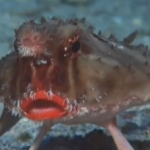Order Lophiiformes: The Anglerfish and Frogfishes
While the order Lophiiformes are sometimes simply refered to by the common name, "anglerfishes," there are plenty of other odd looking, flattened fish. In fact, this family contains about 322 species of mostly benthic shallow-water species. Anglerfish simply represent the classic example. Other common representatives of this group include the goosefishes, monkfishes, frogfishes, sea-mice, sea-toads, handfishes, coffinfishes, and batfishes.
One of the characteristics of many fish in this order is the modified first dorsal-fin spine. The spine often resembles a lure of some kind. Anglerfish use this to their advantage in the deep sea. Batfish and monkfish also use this modified spine to lure in ill-fated fish.
Case of the Frogfish
One of my favorite lophiiform fish families is the Antennariidae, otherwise known as the frogfish. If you’re a diver on reefs across the world, you’ve been trained to spot frogfish and make a big deal about them to the other divers in the group. Generally, the frogfish is an expert at camoflauge. If you’ve never seen a frogfish though. Don’t think you know what this camoflauge is all about. They don’t just blend into the background. Sometimes the mimic pretty bright things, like red sponges. Sometimes they mimic sea squirts, dark patches or holes in the reef. It’s pretty crazy. Fish behaviorists call this type of camflauge aggressive mimicry. They’re sit and wait predators that just sit on the reef. Their body markings help mask it from both the would-be predators and the prey themselves.

The drawing above helps show the odd-looking nature of these froggy fishes. Notice that oddly shaped modified dorsal fin that looks like a lure on the top of the fish’s head. Technically fish experts would call that the rod holding the lure the illicium and the lure itself the esca. The esca is pretty cool, because it is almost always a distinct marking of different species of frogfish. Some mimic shrimp, some worms and some just a blobless lump. You’d think that if a frogfish had a worm-like lure it might be targetting worm-eating fish. While that might be the case, the science doesn’t seem to show it. There isn’t any evidence in the gut-contents of frogfish that they’re selecting prey in this way.
Now, take a look at the pectoral fins that are modified into what seem like little front frog-feet. Bizarre? Yes! Sometimes you’ll see the frogfish wattling across the sand or reef using these modified fins.
This seems like a good time to note that this fish can swim, albiet a bit awkwardly. If you were to disturb him on the reef, he would jet off with a giant propulsion of his tailfin. Yet, they don’t really want to do that. They prefer sitting patiently, cloaked in their own skin, awaiting a meal. All in all, the frogfish is a great example of this bizarre order of fish.
The following video is a fantastic overview of the some of the different lures seen by frogfish. Many thanks to the great Ann and Ned DeLoach (author of the best selling Carribean Fish Identification books).
The Lophiiform Families
- Lophiidae – Goosefishes or Monkfishes
- Antennariidae – Frogfishes
- Tetrabrachiidae – Four-armed frogfishes
- Brachionichthyidae – Handfishes
- Lophichthyidae – Boschma’s frogfish
- Chaunacidae – Sea Toads
- Ogcocephalidae – Batfishes
- Centrophrynidae – Prickly Seadevils
- Ceratiidae – Warty Seadevils
- Himantolophidae – Footballfishes
- Diceratiidae – Doublespine seadevils
- Melanocetidae – Black Seadevils
- Thaumatichthyidae – Wolf-trap Seadevils
- Oneirodidae – Dreamers
- Caulophrynidae – Fanfin seadevils
- Neoceratiidae – Needlebeard seadevil
- Gigantactinidae – Whipnose Seadevils
- Linophrynidae – Leftvent Seadevils
More information on Lophiiformes
- Tree of Life contains an very scientific overview of the order Lophiiformes

































































































